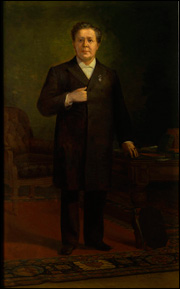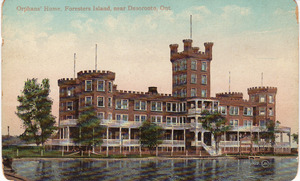Oronhyatekha facts for kids
Quick facts for kids
Oronhyatekha
|
|
|---|---|

Oronhyatekha
|
|
| Personal details | |
| Born | 10 August 1841 Six Nations of the Grand River, Ontario, Canada |
| Died | 3 March 1907 (aged 65) Savannah, Georgia, United States |
Oronhyatekha (born August 10, 1841 – died March 3, 1907) was a remarkable Mohawk doctor and leader. His name means "Burning Sky" or "Burning Cloud" in the Mohawk language. He was also known by his baptismal name, Peter Martin.
Oronhyatekha achieved many amazing things during a time when it was very hard for Indigenous people. He was the first known Indigenous student at Oxford University. He became a successful leader of a large financial company. He was also a strong supporter of rights for women, children, and minority groups. People even thought he was the first Indigenous doctor in Canada, graduating in 1866. He is remembered as a legendary figure in many Indigenous communities.
Contents
Who Was Oronhyatekha?
Oronhyatekha was born on August 10, 1841. His family lived near the Six Nations of the Grand River in Ontario, Canada. He was one of many children.
He first went to the Mohawk Institute residential school. There, he learned how to be a shoemaker. Later, he studied at the Wilbraham Wesleyan Academy in Massachusetts. After that, he taught for a year among Indigenous communities. He then spent three years at Kenyon College in Ohio.
Meeting the Prince of Wales
When Oronhyatekha was 20, he was chosen by the Iroquois Confederacy. This group included the Mohawk, Oneida, Onondaga, Cayuga, Seneca, and Tuscarora Nations. His job was to welcome the Prince of Wales (who later became King Edward VII) to Canada.
It is said that the Prince was very impressed by Oronhyatekha. He supposedly encouraged him to study at Oxford University. However, letters show that the Prince's doctor, Henry Acland, might have had this idea. Acland became Oronhyatekha's mentor and friend. Oronhyatekha started at St Edmund Hall, Oxford in May 1862. He soon returned home to clear his name from some charges.
Becoming a Doctor
After returning to Canada, Oronhyatekha married Ellen Hill. Her Mohawk name was Karakwineh, meaning "moving sun." He also started studying at the Toronto School of Medicine in 1863. He earned his medical degrees in 1865 and 1866.
In 1866, he also served in the Queen's Own Rifles. This was during the Fenian Raids, which were small armed conflicts from the US.
After becoming a doctor, he worked in several towns. These included Frankford, Stratford, and London, Ontario. As his medical practice grew, he became more important in Canada. In 1871, he joined the Canadian National Rifle Team. They competed in Wimbledon, England. In 1874, he was elected President of the Grand Council of Indian Chiefs. This was a group of Indigenous communities in southwestern Ontario.
Leading a Big Organization
In 1878, Oronhyatekha joined the Independent Order of Foresters. This was a group that offered financial help to its members. At first, only white men could join. But Oronhyatekha was also a member of the Orange Order, which helped him get in.
By 1881, he became the Supreme Chief Ranger of the Foresters. This meant he was the international CEO of the organization. He held this important job for 26 years! In 1889, he moved to Toronto, where the Foresters' main office was. Under his leadership, the Foresters became one of the richest financial groups in the world. Today, it has over a million members.
Building a Museum
While leading the Foresters, Oronhyatekha built one of the first museums in North America created by an Indigenous person. It was inside the Foresters' Temple in Toronto. This building was once the tallest office building in the British Empire. It had new technology like electric elevators and lights.
The museum had many interesting things. It displayed natural history items, artifacts from Canadian Indigenous groups, and objects from cultures around the world. After his death, these artifacts were moved to the Royal Ontario Museum in 1911.
Foresters' Island and the Orphanage
In the 1890s, Oronhyatekha bought an island near Deseronto. He named it Foresters' Island. Here, he built a family home, a meeting hall, and even a hotel for guests. He hosted large gatherings for the Foresters on the island every summer.
Oronhyatekha was most proud of an orphanage he started in 1904. It opened in 1906 on the Bay of Quinte, Ontario. He called it his life's greatest achievement. Sadly, he died the next year, and the orphanage was sold in 1908.
Oronhyatekha and Ellen had six children. Only two of them lived to be adults. One son, Henry, drowned at age 10 in a boat accident in 1881. His eldest child, Catherine, married an Australian man. His son Acland also became a doctor but died young, shortly after his father.
Legacy and Honors
Oronhyatekha is remembered and honored in several ways:
- A plaque was put up in Allan Gardens in Toronto where he lived. A nearby lane is named Dr. O Lane.
- A sculpture of Oronhyatekha was moved to the Foresters' new headquarters in Toronto.
- Parks Canada recognized Oronhyatekha as a national historic person in 2001. A plaque was placed at Tyendinaga.
- In 2002, the Royal Ontario Museum and the Woodland Cultural Centre created an exhibit about him. It showed his museum collection.
- A book about his life was written by Keith Jamieson and Michelle Hamilton.


